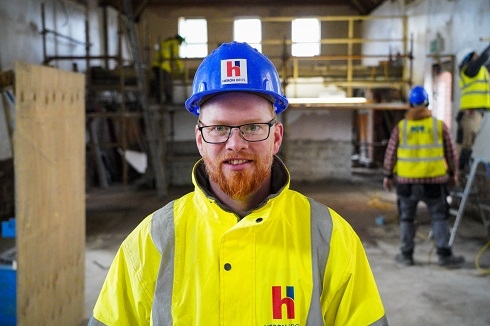The Brook Street school buildings were originally built in 1881 on the site of an older housing development. They were acquired by St Patrick’s Church and vested in the Church of Ireland. Down the years, the premises fulfilled many important roles for the local community. During wartime, they were used as a health centre and in the mid-twentieth century, a large hall, with staging and catering facilities, was added to the site. The old schoolhouse was internally refurbished to provide a modern administrative and teaching centre and used as a gathering place for Sunday schools, youth clubs, community meetings and social events. During elections, it also served as a polling station.
In recognition of the history associated with the site, the restored Victorian B2 listed building will be known as St Patrick’s Centre. It will house a performing arts centre for the new campus and, just like in the past, the facilities will be available as an additional resource for the local community.
A spokesperson for St Patrick’s Parish said they are delighted that Northern Regional College has undertaken such a sympathetic restoration of the premises which will guarantee the ongoing use of the buildings for the education of future generations.
“The Select Vestry sends every good wish and God’s Blessing to the College in this substantial development and looks forward to seeing the old ‘Brook Street Schools’ in their new splendour.”
The main contractor for the Coleraine Campus development is Heron Bros Ltd. Site manager for the Listed Building refurbishment, Diarmuid Mullan said that giving the historic St Patrick’s buildings a new lease of life had become ‘a labour of love’.
A carpenter by trade, Diarmuid honed his restoration skills as a master craftsman while working on the restoration of Georgian buildings in London. He said it was a steep learning curve but now that he is back working in Northern Ireland, he embraces every opportunity to pass on his skills to other members of his team.
Restoration work on old buildings requires focused attention to detail. To help the team feel more confident carrying out the restoration work, Diarmuid organised on-site training to identify both potential problems and how to resolve them, as well as instruction on traditional masonry and carpentry techniques.
Diarmuid explained: “As it was important to retain as many original features of St Patrick’s as possible, any fixtures or fittings that could be repaired, are being recycled and will be reused as the restoration work progresses.”
“Restoration work is labour intensive and time consuming, but now that we are beginning to see the results, I think everyone agrees that it is well worth the extra effort.”
“The repairs we are carrying out to the St Patrick’s building will stand the test of time as quite often the restored item will actually be an upgrade on what was there originally.”
Working from the outside in, remedial work was initially carried out to the exterior of the building. The red Bann bricks were repointed using sand and lime instead of cement, and asbestos below the roof was removed. All the original Bangor Blue slates were salvaged and used to re-roof the building and the decorative detail below the roof repaired and highlighted.
The building’s traditional red brick façade will house a modern performance space and music rooms with high specification equipment. The partitioning walls on the ground floor have been removed to create a bright open space with natural light flooding in from the large sash windows. The original pitch pine King Post trusses have been exposed and will be a prominent feature of the performance space, adding to the sense of spaciousness in the building.
Diarmuid continued: “We encountered dry rot in some of the supporting beams and other woodwork throughout the building, doors, windows, architraves and skirting boards, so we are recycling mahogany beams and other materials salvaged from the former campus to carry out the repairs and further create a sympathetic link between the old and the new.”
Among the original features of the building were panelled pitch pine doors that had been covered with layers of paint. When these are stripped back to expose the grain and panelling, the doors will be waxed, rather than painted. The paint on the large sash windows is also being removed and windows will be recycled and used in the restored building.
When the St Patrick’s building was being cleared in preparation for the restoration work, Diarmuid was delighted to discover an original brass window pulley buried under a pile of rubble. The pulley, like many of the other original fittings and fixtures of the building, will be restored and recycled as part of the restoration project.
Heron Bros, and Diarmuid, have a proven track record when it comes to restoring old buildings. The contractor was named ‘Winner of the Restoration Project of The Year’ at the 2023 CEF (Construction Employers Federation) Excellence Awards and ‘Overall Winner’ for its sympathetic restoration of the iconic Templemore Baths, one of Belfast’s leading heritage restoration projects. At the same event, Diarmuid was also in prestigious company as a Finalist for the 2023 CEF Excellence ‘Award for Outstanding Contributor’ in recognition of his work on the Templemore Baths project.
Northern Regional College’s new campus in Coleraine is on schedule for completion in Spring 2024 and will be fully operational from September 2024, for the 2024/25 academic year.

